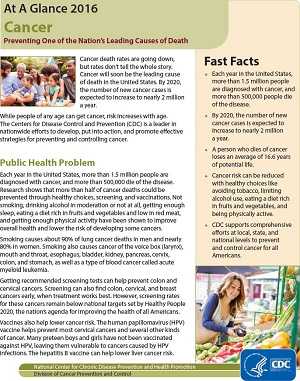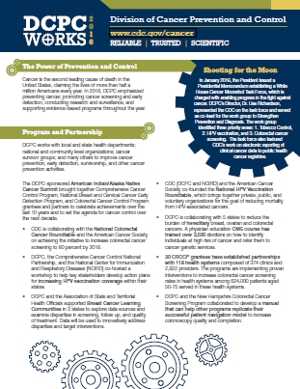About CDC’s Division of Cancer Prevention and Control
CDC is a leader in nationwide efforts to ease the burden of cancer. Through the Division of Cancer Prevention and Control (DCPC), CDC works with national cancer organizations, state health agencies, and other key groups to develop, implement, and promote effective strategies for preventing and controlling cancer.
Ongoing Work
Monitoring
CDC provides funding and assistance to help states, tribes/tribal organizations, and territories collect data on cancer incidence and deaths, cancer risk factors, and the use of cancer screening tests. Public health professionals use the data to identify and track cancer trends, strengthen cancer prevention and control activities, and prioritize the use of resources.
Conducting Research and Evaluation
CDC conducts and supports research designed to help the cancer community better understand the factors that increase cancer risk and identify opportunities to prevent cancer. CDC also evaluates the feasibility and effectiveness of strategies designed to prevent and control cancer.
Building Capacity and Partnerships
CDC works with many partners to translate research into public health programs, practices, and services. To ensure that innovations reach the people who most need them, CDC helps states, tribes/tribal organizations, and territories build the capacity to apply scientific advances to the development of strong cancer control programs.
Educating
CDC develops educational campaigns and materials designed to teach health professionals, policy makers, the media, and the public about cancer prevention and control.
Future Directions
To further its overarching goal of ensuring that people are healthy in every stage of life, CDC will continue to—
- Collaborate with partners, policy makers, and other individuals and groups working to ease the burden of cancer in the United States and abroad.
- Expand the use of information technology in cancer surveillance, particularly in cancer registries.
- Improve the cost-effectiveness of the National Breast and Cervical Cancer Early Detection Program.
- Expand CDC’s role in addressing public health strategies to increase survivorship in underserved populations and improve end-of-life support for cancer patients and their families, friends, and caregivers.
- Define the proper role for management of chronic diseases, including cancer, in the case of catastrophic disaster.
- Page last reviewed: May 17, 2011
- Page last updated: February 16, 2017
- Content source:
- Maintained By:


 ShareCompartir
ShareCompartir

